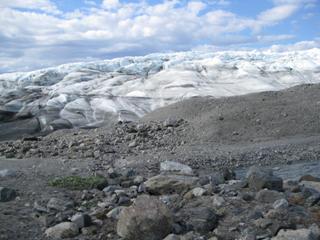Jan 21 2015
Melting of glacial ice will probably raise sea level around the globe, but how fast this melting will happen is uncertain. In the case of the Greenland Ice Sheet, the more temperatures increase, the faster the ice will melt, according to computer model experiments by Penn State geoscientists.
 This image shows a portion of the edge of the Greenland Ice Sheet. (Credit:Patrick Applegate, Penn State)
This image shows a portion of the edge of the Greenland Ice Sheet. (Credit:Patrick Applegate, Penn State)
"Although lots of people have thought about sea level rise from the ice sheets, we don't really know how fast that will happen," said Patrick Applegate, research associate, Penn State's Earth and Environmental Systems Institute.
If all the ice in the Greenland Ice Sheet melts, global sea level would rise by about 24 feet. In the last 100 years, sea level in the New York City area has only increased by about one foot. However, storm surges from hurricanes stack on top of this long-term increase, so sea level rise will allow future hurricanes to flood places where people are not ready for or used to flooding. A vivid example occurred during Hurricane Sandy when parts of the New York City subway tunnel system flooded.
Greenland might be especially vulnerable to melting because that area of the Earth sees about 50 percent more warming than the global average. Arctic sea ice, when it exists, reflects the sun's energy back through the atmosphere, but when the sea ice melts and there is open water, the water absorbs the sun's energy and reradiates it back into the air as heat. Arctic sea ice coverage has decreased over the last few decades, and that decrease will probably continue in the future, leading to accelerated temperature rise over Greenland. Floating ice does not add to sea level, but the Greenland Ice Sheet rests on bedrock that is above sea level.
Feedbacks in the climate system cause accelerated temperature rise over the Arctic. Other feedbacks in the Greenland Ice Sheet that contribute to melting include height-melting feedback. A warm year in Greenland causes more melt around the edges of the ice sheet, lowering the surface. The atmosphere is warmer at lower altitudes, so the now lower surface experiences even more melting. This process can lead to accelerated ice melt and sea level rise.
Another form of feedback occurs because ice sheets are large masses that want to spread. This spreading can either help preserve the ice sheet by allowing it to adjust to increased temperature or accelerate ice melting by moving ice to lower, warmer, places.
"Many studies of sea level rise don't take into account feedbacks that could cause rapid sea level rise," said Applegate. "We wanted to look at the effects of those feedbacks."
The researchers looked at two models of the Greenland ice sheet that include some of the important feedbacks. The first model is a three-dimensional ice sheet model. The second model looks at a transect across the island and was developed by Byron Parizek, associate professor of geosciences and mathematics, Penn State Dubois. To run both models, Robert Nicholas, research associate, EESI, estimated how much warming might take place over Greenland using results from global climate models.
Both the three-dimensional and transect models showed that the time necessary for ice mass loss from the Greenland ice sheet decreases steeply with increases in temperature. Shorter time scales -- faster melting -- imply faster sea level rise. The interplay between the height-melting feedback and ice flow causes this acceleration.
"Our analysis suggests that the benefits of reducing greenhouse gas emissions, in terms of avoided sea level rise from the Greenland Ice Sheet, may be greatest if emissions reductions begin before large temperature increases have been realized," the researchers state in a recent issue of Climate Dynamics.
Currently, about a billion people -- 1 percent of the world population -- live in areas that would be flooded by a three-foot sea level rise.
"If we are going to do something to mitigate sea-level rise, we need to do it earlier rather than later," said Applegate. "The longer we wait, the more rapidly the changes will take place and the more difficult it will be to change."